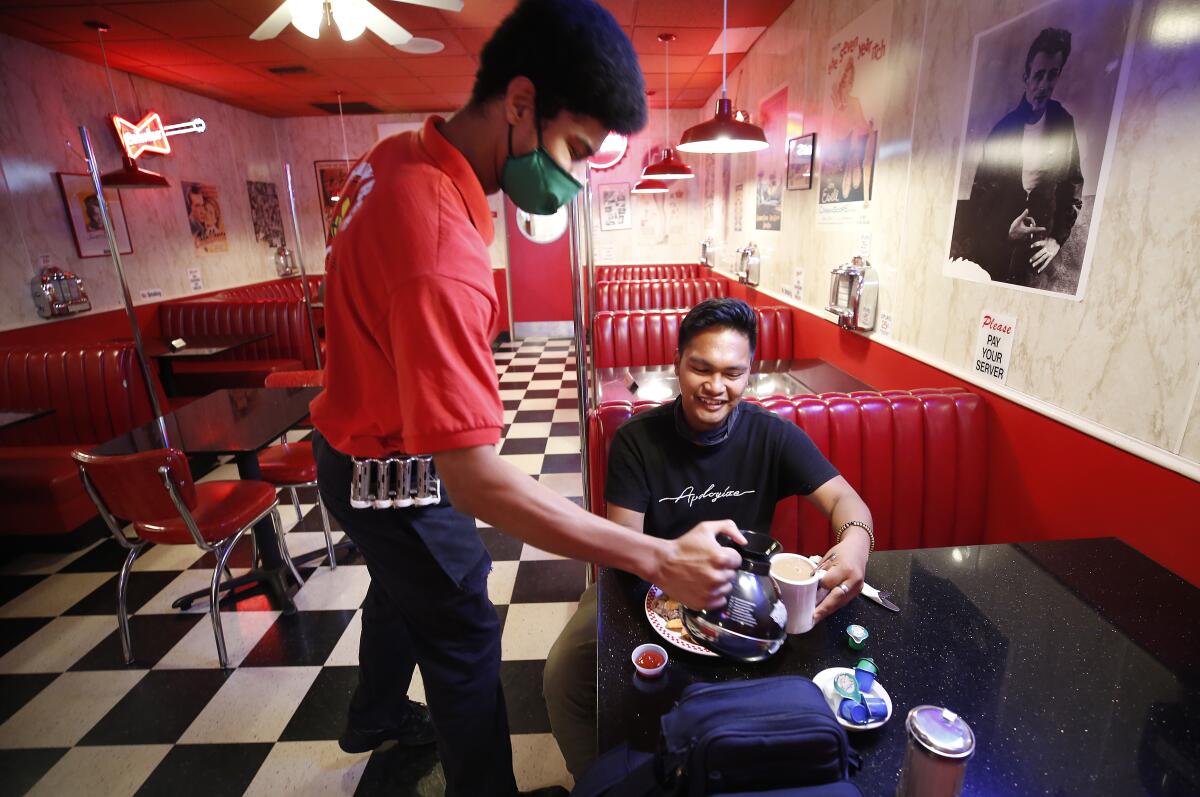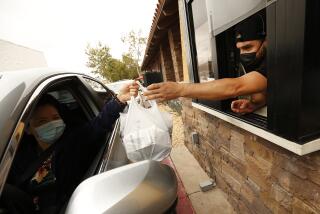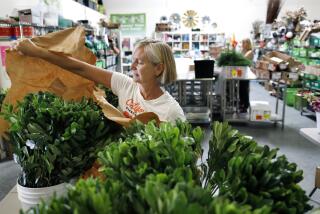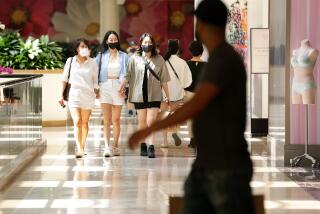With masks, temperature checks and anxiety, California’s retail economy gingerly reopens

Linda Sims tucked into a booth across from her husband Anson Saturday in the back of the Busy Bee Café in downtown Ventura.
Her first decision took some judgment: entering a restaurant for the first time since the coronavirus stay-at-home order was imposed. The second decision was easier: getting the pancakes.
“We come here every Fourth of July,” she said of the 1950s-style diner. “And this is where we always have breakfast.”
The Simses, who wore face masks while waiting on the sidewalk for a table, said they know there’s a risk in reopening now, but it has to happen sometime.
“We’re at the vulnerable age,” she added. “But you know what? You’ve got to dip your toe [in]. If they’re willing to open up knowing that it’s safe — they’re not going to kill us — we need to patronize them. I’m going batty by being in the house.”
After more than two months on lockdown, large swaths of California’s retail economy began coming back to life Saturday. This marked the first weekend since many counties got the go-ahead to reopen restaurants, retail stores and even shopping malls for business.
The easing of coronavirus lockdowns allows small businesses to reopen in phases. Two small retailers — Kitson and Little Trendz — find it difficult.
Some once-bustling shopping and entertainment districts across California did see a burst of customers, though it’s far too soon to tell whether it will be enough to make the businesses sustainable.
Restaurants were supposed to open with a swath of new safety rules including face masks and temperature checks for employees and social distancing for customers.
For the most part, merchants and customers did their part. But there were some exceptions.
El Prez, a bar in San Diego’s Pacific Beach district, came under the spotlight after patrons posted videos featuring crowds of people drinking, often maskless and far closer to each other than the six-foot standard set for restaurants under newly approved reopening guidelines. County Supervisor Nathan Fletcher said the scene created “an imminent health and safety risk” and said county health officials served the business with a closure notice.
State officials have now cleared 45 counties to resume in-restaurant dining and in-store shopping. The latest were Orange and Riverside, two of California’s largest population centers. Orange County had seen a spike in deaths over the last week, and officials said they were thrilled they could begin reopening the battered economy.
Before reopening, businesses must review state guidance relevant to their industry, prepare and implement a safety plan and post an industry-specific checklist in their workplaces.
“We understand that many businesses are hurting at this time and greatly want to reopen with as little issues as possible,” county Supervisor Don Wagner said.
“We’ve basically wiped out a decade worth of job creation in a month and a half,” an economist says. May’s unemployment figures will probably look even grimmer.
The Orange County reopening was made possible after Gov. Gavin Newsom on Monday adjusted the requirements counties must meet to accelerate their reopening schedules. Most notably, Newsom announced that counties would no longer be kept from loosening stay-at-home rules if they have recorded COVID-19 deaths in the previous two weeks.
Local leaders can now move toward a more expansive reopening if they can show fewer than 25 coronavirus cases per 100,000 residents in the last 14 days, or show that fewer than 8% of residents tested positive for the virus over a seven-day period. Data submitted by Orange County last week show that 7.95% of residents tested for the virus between May 13 and Tuesday were positive, coming in just under the state’s maximum.
Orange County public health officials Saturday reported 12 new coronavirus-related deaths, bringing the county’s overall death toll to 130. Nearly a third of the fatalities were recorded in the past four days, with 10 deaths recorded Wednesday, 14 Thursday and six Friday. Before Wednesday, the county hadn’t reported more than five deaths in a single day.
Officials said that many of the new deaths are due to outbreaks in skilled nursing facilities. In total, 52 residents of skilled nursing facilities had died as of Saturday.
The county also reported an additional 216 cases of the virus Saturday, bringing the countywide infection total to 5,157.
Los Angeles County, the epicenter of coronavirus in California with more than 2,000 deaths, has been slower to expand reopening. Officials set a goal of reopening by July 4.
Los Angeles County public health officials announced on Saturday 1,032 new cases of the coronavirus and 41 related deaths but also revealed encouraging signs of progress in slowing the virus’s spread.
The county has seen a 13% decrease in its latest seven-day average of deaths per day and a 16% decrease in its most recent three-day average of hospitalizations per day, according to a Department of Health dashboard that tracks metrics related to recovery.
In addition, the percentage of people who have tested positive in L.A. County has reached an all-time low of 8.5%, compared with 28% in New York City, said Barbara Ferrer, the county health director, on Saturday.
Her comments came the day after the White House coronavirus response coordinator, Dr. Deborah Birx, singled out Los Angeles as one of three metropolitan areas that has seen a persistently high number of new daily cases, which she said was a cause for concern.
With unemployment now at 15.5% in California, there is hope that easing the stay-at-home restrictions will bring some recovery.
The door was open although the restaurant was technically closed late Saturday morning when the first group of curious customers filed into Nature’s Grill, Thomas Larsen’s storefront cafe in Ventura.
“We open at 11,” Larsen whispered with a shrug, a cloth face covering hiding a smile as he glanced at his watch. It read 10:55.
No one, least of all Larsen, wanted to wait another five minutes for the restaurant to open, not when they’ve already waited more than two months.
“Business isn’t going to come rushing back,” said Larsen, whose Main Street storefront sits along a trendy five-block stretch of bars, boutiques and restaurants in downtown Ventura, a half-mile from the beach. “It’s been a struggle. But I think everyone’s navigating it the best they can.”
Larsen said the shutdown crushed his business, forcing him to lay off all but a handful of his 16 employees and dip into his personal savings to avoid closing completely. To reopen, restaurants must agree to county rules requiring face coverings and temperature screening for all employees, ample social distancing for customers and the thorough cleaning of menus, tabletops and other frequently touched objects.
And while Larsen may fudge the rules when it comes to opening time, he’s sticking to the ones that will keep those doors open. That means closing every other booth in his restaurant, moving some of the maple chairs and tables outside and serving food in disposable containers.
“I’m going to overdo it,” he said. “I’d rather be overcautious right now. The whole pandemic is something you need to worry about. Just packing people into restaurants at this point isn’t smart.”
For Larsen, the fear of the novel coronavirus isn’t theoretical. His sister, a nurse in Santa Barbara, was tested three weeks ago after coming into contact with a COVID-19 patient; the hours waiting for the results were long.
“It’s absolutely a real thing,” Larsen said. “It’s something that everyone needs to take seriously. People are going to have to decide for themselves when it’s safe to come out and dine. Some are going to take their time.”
Times staff writer Hannah Fry and Lyndsay Winkley of the San Diego Union-Tribune contributed to this report.
More to Read
Start your day right
Sign up for Essential California for news, features and recommendations from the L.A. Times and beyond in your inbox six days a week.
You may occasionally receive promotional content from the Los Angeles Times.











